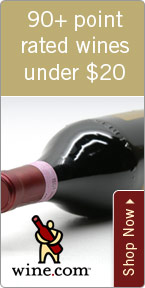Looking For ‘Finesseful’ Wines

Wednesday - February 03, 2006
| Share
 Del.icio.us
Del.icio.usFinesse. This is a word wine writers use to describe wines that have an elegance, softness as well as balance to them. To me finesse is exemplified by a gazelle as it springs over a pasture to elude a cheetah, as opposed to the mass and clumsiness of an angry gorilla. Finesse does imply that the wine is not so “big,” full-bodied or heavy. Finesse should not mean light, or lacking concentration, for as you know a gazelle needs plenty of power and strength in its legs to out-run its predator. But finesse is a word that is found less and less in the world of wine, much like an endangered species. Words like big, huge, “over the top,” tons, loads, extracted, prodigious and mammoth are more prevalent, especially in the high scoring end of the spectrum.
Why? Is it global warming? Are wines just reaching higher alcohol levels, more ripeness and better flavor because of temperature increases in the world? Having just visited Burgundy, several winemakers commented that they were used to only getting three in every 10 years ripe; now they can count on nine out of 10 because of rising temperatures. Even Germany, despite its northerly latitude, has enjoyed an unprecedented decade-long string of high-quality vintages where ripeness levels were not a source of worry. But even so, there are still plenty of winemakers in the world who are making finesseful wines even with these same conditions in every corner of the globe. Just because they can, does-n’t mean they will.
Is it a reflection of our culture? Athletes have certainly gotten bigger and stronger. Take tennis, for example. What used to be a game of finesse is now dominated by cannon service games and the powerful backhand. In basketball, the dunk, the epitome of strength and power, is featured on every highlight reel. Even in the media, it has to be shocking or controversial to get noticed. And look at the automobile - bigger, stronger and more “bling.” Perhaps the general public’s sensory perception has been deadened. We are constantly bombarded by media and “the next big thing.” It’s easy to see why we want big and powerful wines that jostle our senses. Otherwise, we don’t get a “kick” out of them or they just seem to be “hum-drum.”
But wine to me isn’t one of those things that is necessarily better just because it’s bigger and more powerful. Literally, it’s easy for winemakers to make bigger wines. They just leave the grapes on the vine longer, use concentrators and dehydrators in the winemaking process; they age the wine in new oak and even add sugar and coloring agents to make the wine sweet and dark enough for people to drink them. But what happens as a result is that the wines become more homogenized. In order for winemakers and vine growers to achieve the ultimate result of a 100 point wine which they can sell for astronomic prices, they use the same techniques, most often overshadowing or masking any of the intrinsic characteristics of the vineyard or what the French call “terroir” in the wine. We lose individuality and the sense of place that wine uniquely offers, something practically no other beverage in the world can claim, which to me is one of the joys of wine.
Finesse is a character I like to find in the wines that I drink most often. It keeps me coming back for more. It doesn’t dull my senses; rather they refresh me. Wines with finesse also work better with a wider range of food. The mammoth, blockbusting wine has to have something just as big in order to match. Not that power and massivity don’t have a place in the wine world. But finesse will never go out of style.
Recommended finesse wines:
* 2004 Hippolyte Reverdy, Sancerre ($18). A “classic” expression of Sauvignon Blanc, mineral laden, flowery and citrus aromas. I often have cravings for this wine with shellfish and salads.
* 2002 Domaine Roulot Bourgogne Blanc ($22). 100 percent Chardonnay from the lowest level of appellation in Burgundy but, oh, is it way better than its official label. It’s so refreshing with great intensity of fruit and an extended aftertaste that lasts until you have another sip.
* 2003 Michel Faraud, Domaine du Cayron, Gigondas ($20). Grenache from the Southern Rhone doesn’t always have to be overbearing and heavy. This one is juicy, spicy and just puts a smile on my face, without knocking me out with alcohol. Savory flavored white or red meat has an affinity for this wine.
Roberto Viernes is a master sommelier. E-mail .(JavaScript must be enabled to view this email address)E-mail this story | Print this page | Comments (0) | Archive | RSS Comments (0) |
Most Recent Comment(s):












